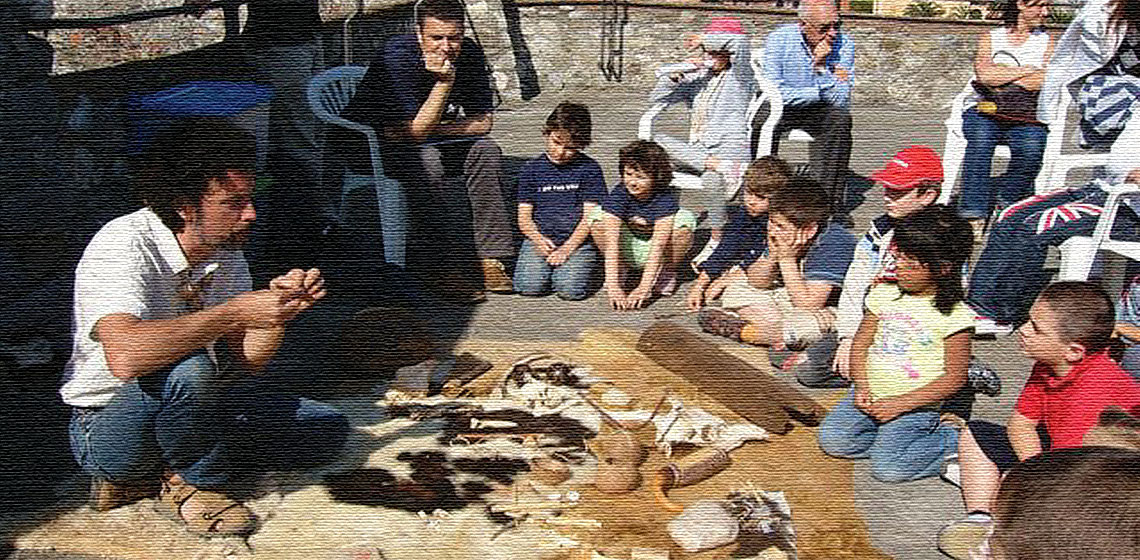
The paleofestival has taken place annually in La Spezia, Italy, since 2005. It is a very popular, engaging event which combines experimental prehistoric archaeology with other educational activities. Museums, parks, and Italian and foreign archaeologists can meet at the festival to promote their activities to a wider audience.
In 2000 the Italian archaeological museum of La Spezia moved to the renovated Castello di San Giorgio which is in the city centre. The building is still the most representative monument of the history of the city. Situated on a small hill, overlooking the town of late medieval period, the fortress has been undergoing several phases of construction, documented from the second half of the 14th century. Since the reopening in 2000 vistitors’ emotional involvment, together with their over all knowledge, has increased thanks to educational activities and experimental archaeology labs.
As a result of this growing awareness of the potential of experimental archeology as a vehicle to disseminate prehistory, we devised the event in 2005 and also exploited the potential of the castle park where it is generally performed. Thanks to the participation of special technical operators, most of them graduates in archaeology or from open-air museums and archaeological parks, the festival offers activities that are increasingly diversified.
Today Paleofestival is a two-day event at the end of May where activities for both adults and children are available: they can experience the initial ignition of fire, stone chipping, the use of a bow thruster, milling of cereals, animal slaughter, the creation and firing of pottery, weaving, rock painting, working horn, plant identification from seeds, use of primitive musical instruments, and copper and bronze smelting.
Recently the performances also included workshops about Mesopotamia and Ancient Egypt. The new activities have been more and more engaging such as recordings of cuneiform tablets, writing hieroglyphics on papyrus and a game that incited people to answer questions incorrectly (rather than right!) to be bandaged like a mummy before the end of the game.
This event has the merit of having an experimental archaeologist who can share their own experience and give their contribution to the developing of new interesting activities: indeed they have the chance to argue out several technical topics related to their job and come into contact with different situations.
During the last edition of Paleofestival, some visitors offered their own creations suche as incised shells or stones, tools ... making the set even more real than it’s before.
Today interactive and educational workshops are held at the museum and have stimulated the creation of an event born in 2005, which includes activities carried out by external experts and institutions such as museums and archaeological parks.
Besides the possibility for visitors to experience a weekend of true antiquity, the event is completely free and it is a great opportunity to exchange experiences among technical and educational incentive for operators of other museums.
Other Italian EXARC members, like the Museo delle palafitte di Ledro, Archeoparc Senales, Roberto Deriu of Gesti Ritrovati, technical operators from Parco di Forcello and Enrico Belgrado of Archeolab have attended the event.
The great potential for geographical proximity of protected areas such as Cinque Terre National Park (UNESCO) or cities that have large flow of tourists throughout the year as Genoa Pisa and Florence bodes well for this event that takes place in a very favourable period for outdoor activities.
At the last edition more than a thousand children accompanied by adults, despite the good weather, have besieged the Castle of St. George rather than going to the sea: adults have had their share of entertainment with the professional archaeologists and experimentalists too. Children however, programs in hand, ran from one laboratory to another dragging parents and grandparents. This is an event that grows more and more, and it is now a great example to follow for other operators for teaching in other countries.
The event is becoming more elaborate due to the particular demands of operators who require working spaces with different characteristics such as near a water source, presence of weeds, wind direction, stone walls, a grass flat ground to walk on, firewood, and so on. It’s always been essential to establish contact with the selected members months before the event to plan accommodations for guest professionals who come from farther away. In 2010 the Castle had the honour of hosting Lascour Vincent, one of the best French archaeologists specialising in flint and obsidian chipping. It is no secret that the ambition of the organizers is to make this local event an increasingly international one, possibly thanks to increased sponsor attention.
All photos taken at August 2010 Paleofestival

Bibliography
RATTI, E., La preistoria e la sua divulgazione attraverso la sperimentazione interattiva – tesi di laurea, vol. MA, Genova, Università di Genova, 2004.